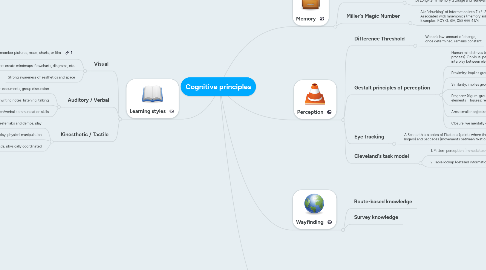
1. Learning styles
1.1. Visual
1.1.1. More likely to remember pictures, maps, charts, or film
1.1.2. Learners create mindmaps, flowcharts, diagrams, etc.
1.1.3. Strong awareness of aesthetics and space
1.2. Auditory / Verbal
1.2.1. Prefer lectures, written documents, group discussion
1.2.2. Study by reading, writing notes, listening, talking
1.2.3. Strong written/verbal communication skills
1.3. Kinesthetic / Tactile
1.3.1. Prefer labs and demos, play
1.3.2. Learn by acting, role-play, physical manipulation
1.3.3. Work well with hands, physically coordinated
2. Memory
2.1. Stage Theory Model
2.1.1. [1] Sensory input (notice, filter, iconic memory) [2] Short-term memory (process and storage) [3] Long-term memory (storage and retrieval)
2.2. Miller's Magic Number
2.2.1. Aka "chunking" of information into 7 +/- 2 parts. Associated with mnemonics (memory aids). Examples: ROY G. BIV, 058 666 4174
3. Perception
3.1. Difference Threshold
3.1.1. Weber's law: amount of change, once determined, remains constant
3.2. Gestalt principles of perception
3.2.1. Human mind strives to self-organize (holistic process). On visual perception this looks at the interplay between elements and composition.
3.2.2. Proximity: implies grouping or like meaning
3.2.3. Similarity: implies grouping
3.2.4. Prägnanz (figure-ground relationship): dominant elements = figures; recessive elements = background
3.2.5. Area: smaller objects usually figures on background
3.2.6. Closure: we mentally close up objects
3.3. Eye tracking
3.3.1. A Scanpath is a series of Fixations (points where the user lingers) and Saccades (movements between fixations).
3.4. Cleveland's task model
3.4.1. 1. Pattern perception (immediate overview)
3.4.2. 2. Table lookup (detailed information)
